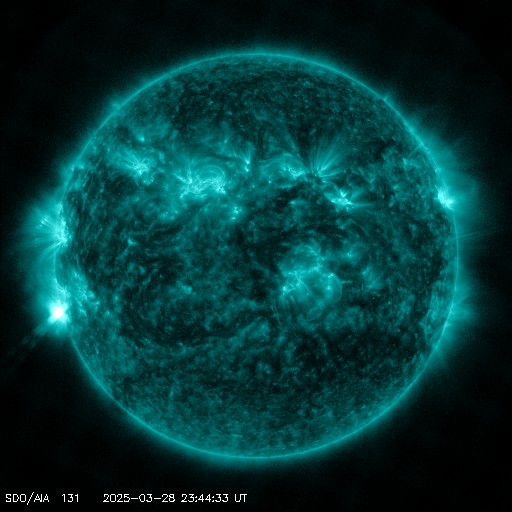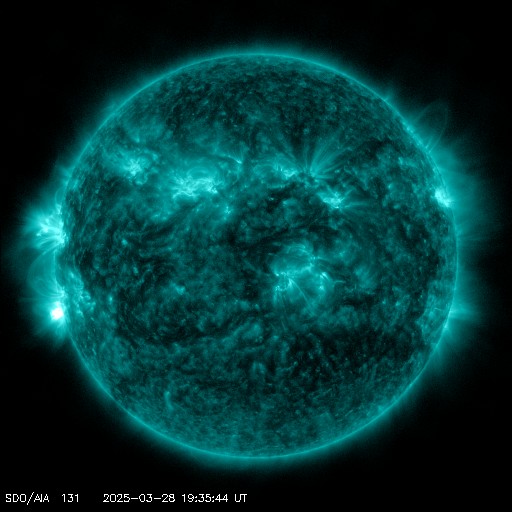Viewing archive of Wednesday, 22 August 2001
Solar activity report
Any mentioned solar flare in this report has a scaling factor applied by the Space Weather Prediction Center (SWPC). Because of the SWPC scaling factor, solar flares are reported as 42% smaller than for the science quality data. The scaling factor has been removed from our archived solar flare data to reflect the true physical units.
Report of Solar-Geophysical Activity 2001 Aug 22 2200 UTCPrepared by the NOAA © SWPC and processed by SpaceWeatherLive.com
Joint USAF/NOAA Report of Solar and Geophysical Activity
SDF Number 234 Issued at 2200Z on 22 Aug 2001IA. Analysis of Solar Active Regions and Activity from 21-2100Z to 22-2100Z
Solar activity increased to moderate levels. An M1
X-ray flare peaked at 21/2157 UTC associated with moderate discrete
radio bursts and a Type II radio sweep (estimated velocity 740
km/sec). LASCO/EIT images indicated that Region 9591 (S17E63) was
the source for this flare. It was also the likely source for an M1
X-ray flare that peaked at 22/1216 UTC. This region also produced
occasional, impulsive low- to mid-level C-class flares during the
period. Region 9591 continued to rotate into view as the day
progressed and is now classed as a moderate-sized F-type spot group.
Limb proximity prevented a detailed analysis of this region's
magnetic structure, but recent activity suggests at least a moderate
degree of magnetic complexity. No remarkable changes occurred in the
remaining active regions, including newly numbered Region 9592
(S09W59).
IB. Solar Activity Forecast
Activity is expected to be moderate
with a good chance for isolated M-class flares from Region 9591.
There is also a slight chance for a major flare from this region.
IIA. Geophysical Activity Summary 21-2100Z to 22-2100Z
Geomagnetic field activity was at quiet to unsettled levels until
22/0300 UTC, then increased to unsettled to active levels for the
remainder of the period. This activity was due to a high-speed
stream associated with a recurrent, negative-polarity coronal hole.
IIB. Geophysical Activity Forecast
Geomagnetic field activity is
expected to be at unsettled to active levels through the period.
There will be a slight chance for a proton event during the period.
The greater than 2 MeV electron flux at geosynchronous orbit may
reach high levels during the first half of the period.
III. Event Probabilities 23 Aug to 25 Aug
| Class M | 50% | 50% | 50% |
| Class X | 10% | 10% | 10% |
| Proton | 05% | 05% | 10% |
| PCAF | green | ||
IV. Penticton 10.7 cm Flux
Observed 22 Aug 162 Predicted 23 Aug-25 Aug 170/175/180 90 Day Mean 22 Aug 151
V. Geomagnetic A Indices
Observed Afr/Ap 21 Aug 012/014 Estimated Afr/Ap 22 Aug 016/018 Predicted Afr/Ap 23 Aug-25 Aug 015/012-012/010-015/012
VI. Geomagnetic Activity Probabilities 23 Aug to 25 Aug
| A. Middle Latitudes | |||
|---|---|---|---|
| Active | 30% | 20% | 30% |
| Minor storm | 15% | 10% | 15% |
| Major-severe storm | 05% | 01% | 05% |
| B. High Latitudes | |||
|---|---|---|---|
| Active | 35% | 25% | 35% |
| Minor storm | 20% | 15% | 20% |
| Major-severe storm | 10% | 05% | 10% |
All times in UTC
Current data suggests there is a slight possibility for aurora to appear at the following high latitude regions in the near future
KirkenesMurmansk
Latest news
Latest forum messages
AR4048 2Incoming & Unnumbered Active Regions 1658Aurora photography hints for those of us with smartphones 51AR4046 127Large Coronal Hole 25 178
More topicsSupport SpaceWeatherLive.com!
A lot of people come to SpaceWeatherLive to follow the Sun's activity or if there is aurora to be seen, but with more traffic comes higher server costs. Consider a donation if you enjoy SpaceWeatherLive so we can keep the website online!

Latest alerts
00:00 UTC - Solar flare
Moderate M1.79 flare
Friday, 28 March 2025
23:36 UTC - Radio Blackout
Minor R1 radio blackout in progress (≥M1 - current: M1.04)
21:24 UTC - Hemispheric Power Index
The OVATION model predicts the Hemispheric Power Index to reach 51GW at 21:59 UTC
19:45 UTC - Solar flare
Moderate M1.16 flare
19:27 UTC - Radio Blackout
Minor R1 radio blackout in progress (≥M1 - current: M1.1)
Space weather facts
| Last X-flare | 2025/03/28 | X1.1 |
| Last M-flare | 2025/03/28 | M1.7 |
| Last geomagnetic storm | 2025/03/27 | Kp5 (G1) |
| Spotless days | |
|---|---|
| Last spotless day | 2022/06/08 |
| Monthly mean Sunspot Number | |
|---|---|
| February 2025 | 154.6 +17.6 |
| March 2025 | 128.3 -26.4 |
| Last 30 days | 128.3 -23.7 |




